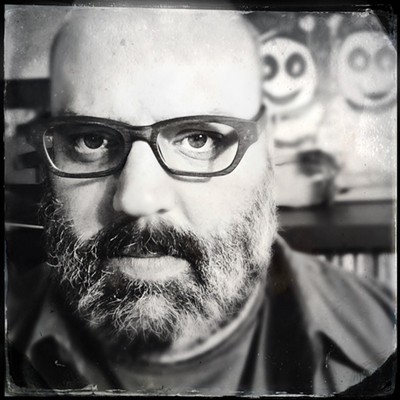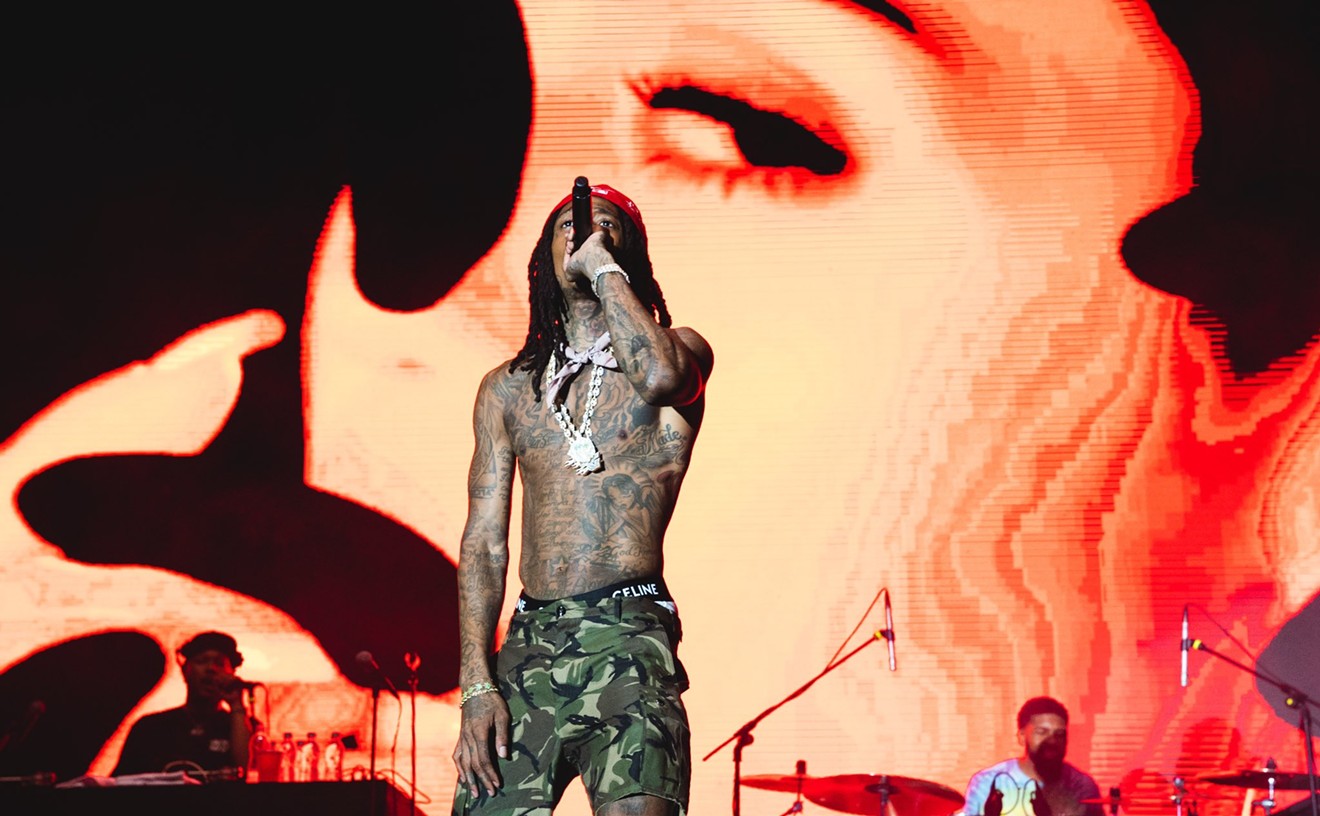Coldplay, Jon Hopkins, Sleeper Car
Friday, Nov. 21, 2008
Pepsi Center
Better Than: A rock show where the band stays rooted in one spot.
Making an arena rock show personal may seem like an impossible task, especially for any band playing to thousands of fans in the airy expanses of the Pepsi Center.
But Coldplay defied the inherent limitations of its grandiose setting Friday night, offering a performance full of immediacy and intimacy despite the large venue. Even with a complex stage show marked by massive moving set pieces and elaborate video work, the band kept the performance rooted in a direct rapport with the audience.
All told, it was an impressive feat.
The band's ability to fuse the epic and the intimate elements of its performance made for a show that was impressive in myriad ways. The
giant globes, the great piles of confetti released into the audience,
the massive screens hung from the ceiling - all of these arena-scale
ingredients were complemented by the band's movement around the large
space.
By shifting spots on the main stage and even taking its performance to the upper rings of the Pepsi Center, the group escaped
the typical arena model and made the night much more memorable.
Considering
the large-scale stagecraft that would mark Coldplay's entire set, the
evening started out on a decidedly low-key note. Predictably, opening
band Sleepercar's set occupied a fraction of the stage and a fraction
of the time of the headliners. But the El Paso, Texas-based quintet's
sound offered a dynamic markedly similar to that of the main act in both
structure and content.
While lead singer Jim Ward's alt-country
tones contained the sounds and contours of the band's West Texas
musical roots, the plaintive pace and straightforward chords
recalled Coldplay's debut album, Parachutes.
While
Sleepercar's set provided a preview of the show to come in terms of
sound and structure, Jon Hopkins's performance veered much farther from
Coldplay's musical guideposts. As a large screen displayed a series of
psychedelic animations by Vince Collins, Hopkins worked like a mad
scientist over a MacBook Pro and a mixing board. What started out as
electronic music marked by sparse chords and syncopated percussion
eventually intensified in pace and in volume. Hopkin's uncanny ability
to match his frenzied and changeable rhythms with the bright animation
sequences helped carry his set.
Immediately after Hopkins's set,
handlers and techies scrambled to configure the stage for Coldplay's
performance. While the layout seemed straightforward - a main stage
with long walkways on either side - the band would make full use of its
space in creative ways.
The instrumental "Life in Technicolor"
served as the opening theme. Long tapestries that had hid the
stage rose to the rafters as the band put the final tones on the
opening track from the new album, Viva la Vida.
Coldplay immediately mixed old and new into its set list, with the first three
songs, "Violet Hill," "Clocks" and "In My Place," running the gamut from
the band's latest release to 2002's A Rush of Blood to the Head. The
sophisticated stagecraft started in earnest early on, as complex laser
patterns shot into the crowd and lead singer Chris Martin ran the
expanse of the stage and its side walkways within the first five
minutes of the performance.
Martin's animated energy was on
display from first phases of the set. "In My Place" saw him constantly
exhorting participation from the crowd, extending the mike toward
throngs eager to supply the words. As the band rang the song's final
tones, Martin collapsed on his back on the side stage. Guitarist Guy
Berryman hefted Martin back to his feet.
Despite the pure theatricality of such antics, Martin managed to keep the feeling of his performance genuine.
As the band broke into "Speed of Sound" from X&Y,
massive orbs descended from the heights of the ceiling. The weather
balloon-sized spheres blazed bright with primary colors, and as the
evening progressed, live video images from the stage were projected in
layers from their surfaces. The stage pieces made for a grandiose
atmosphere, which was lessened somewhat when the house lights came on
and Anderson addressed the Denver crowd directly.
It was a
dynamic that would repeat throughout the performance. Just as the giant
orbs, the flashing lights and the huge projections on three different
screens seemed overly theatric, the band would change the parameters of its performance to make it more cozy and involved.
For the performance of "God Put a Smile Upon Your Face," from A Rush of Blood to the Head,
for example, all four of the bandmembers crowded on a small space at
the end of the walkway on stage left. As Martin, Berryman, Jonny
Buckland and Will Champion lined up on the cramped platform, the floor
lit up in segmented squares and washed them in a fluorescent glow. The
stark performance of the song, which featured drummer Champion's
impressive skills on electronic drums, helped to ground the performance
and place the band in the midst of the crowd.
Martin remained
on the platform with his piano after the other three members left,
giving a solo rendition of "The Hardest Part" from X&Y and
labeling it his "ego moment." The rendition, which featured Champion on
harmonies from the darkened main stage, provided yet another low-scale
relief to the epic feel of the venue and the sets.
While the
subsequent performances of "Viva la Vida" and "Lost!"
featured much fuller instrumentation, including a massive percussion
round on the timpani for "World," the final two songs of the first set
calmed the energy significantly.
After "Lost!," the bandmembers descended from the stage, winding their way through the crowd on the
floor. As they progressed through the front rows, hiked up the stairs
and settled at one of the upper rings toting acoustic guitars, it
seemed as if Coldplay had decided to take an impromptu tour of the
Pepsi Center in order to relax a bit.
Instead, the journey
through the throngs turned out to be one of the most memorable musical
moments of the evening. The band cleared out a small space amid the
fans long enough to play dynamic acoustic versions of "The Scientist"
and "Death Will Never Conquer." The latter featured the vocals of
Champion, as Martin complemented the chorus of "Let me know, boys, let
me know" with harmonies blown through a harmonica.
The band
disappeared just long enough to make its way back to the main stage
and indulge in a few moments of rest. When it returned with a
high-volume, high-energy version of "Politik," all of the grandiose
stage cues were back. The globes descended, the lasers beamed, and
strobed lights flashed across the crowds.
Martin's punctuated
piano solo served as an introduction and a calm bridge to "Lovers In
Japan," but as black and white images flashed across the massive screen
at the back of the stage, the band quickly revved up the energy level
once more. As the frequency of the film clips increased and the song's
pace intensified, masses of confetti fell from the rafters. The release
spots were strategic - despite the large scope of the arena, the
butterfly-shaped snips of paper seemed to cover the majority of the
floor and the upper tiers.
Even as the band broke into "Death
Will Never Conquer" and Martin started to voice the band's farewells,
the paper butterflies continued to fall. The extended version of
"Death" roused the already frenzied audience, and as the band made its
second exit, no one seemed to make a move to leave.
The crowds did not have to wait long. Mere minutes after the last strains of
"Death" rang out, the band came back to play the single that earned it its first fame, "Yellow."
In all, the Pepsi Center
performance was in no way hampered by its massive scale. Coldplay
delivered all of the fireworks and flair requisite for its status as
a commercial, stadium rock band - but in between, the group achieved a much more remarkable dynamic. While maintaining the epic scope, Coldplay sneaked in moments of pure audience rapport.
Despite the
screaming hordes and the dizzying size of the arena, the band created the illusion of a small club performance at several key points.
Considering the venue, it was no small achievement.
Personal bias:
I first heard Coldplay when I was living in France in 2002 -- and
Friday's live renditions of the Blood songs, combined with the massive
projection on the back screen of the cover art from Vida ("Liberty
Leading the People" by French painter Eugene Delacroix) gave the show
an evocative, transportive power.
Random detail:
Extremists on both sides of the Coldplay debate tend to be annoying.
Those who worship every syllable that Chris Martin utters and those who
harp on how the band represents all that is evil in the commercial
music industry rub me the wrong way. Obviously, the show was populated
by a high number of folks in the first category. Two-plus hours
surrounded by such fanatics can grow old fairly fast.
By the way: Chris Martin's heavy use of falsetto can get a bit annoying after almost two hours.
- A.H. Goldstein
Setlist
1) Opening theme - Life in Technicolor
2) Violet Hill
3) Clocks
4) In My Place
5) Speed of Sound
6) Cemeteries of London
7) Chinese Sleep Chant
8) 42
9) Fix You
10) Strawberry Swing
11) God Put a Smile Upon Your Face
12) The Hardest Part
13) Viva la Vida
14) Lost!
15) The Scientist
16) Death Will Never Conquer
Encore 1
1) Politik
2) Lovers in Japan
3) Death and All His Friends
Encore 2
1) Yellow











